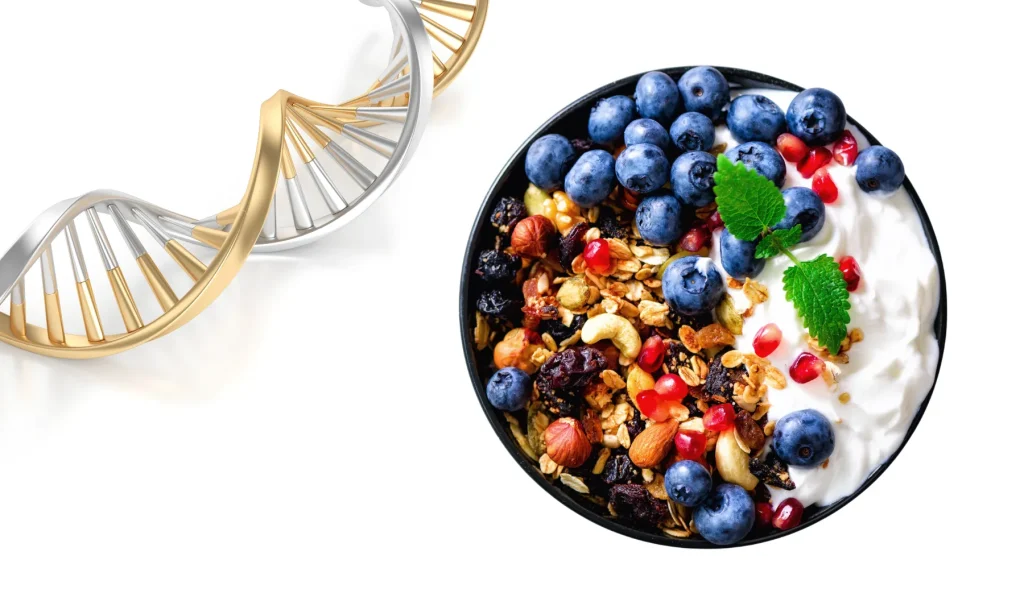
Picture this: two patients, both struggling with stubborn weight gain, sitting in your clinic. You hand them identical diet plans. One thrives, energy soars, pounds drop. The other? Not a budge, not even a break in their cravings. If you’ve been in practice for more than a week, you know this isn’t rare. It’s the riddle at the heart of nutrition science, and nutrigenomics finally offers a key.
What if you could peek beneath the hood, past signs and labs, and see how each patient’s DNA shapes their response to the foods you recommend? That’s the premise of a nutrigenomics assistance plan: using genetics to tailor diets not just for trends, but for the actual person in front of you. And it’s not science fiction anymore. With a simple cheek swab and the correct interpretation, you can optimize nutrient intake, balance metabolism, and, most importantly, finally see stubborn outcomes move for chronic issues like diabetes, obesity, cardiovascular conditions, and more.
Sure, the science can sound daunting. SNPs, epigenetics, methyl donors, it’s a lot to take in. But here’s the thing: you don’t need to be a geneticist to leverage these tools. Let’s dig into the key steps, real-world examples, and more intelligent workflows to help you navigate this new frontier and deliver better results for your patients, one gene at a time.
Key Takeaways
A personalized nutrigenomics treatment plan uses genetic insights to tailor nutrition strategies for each individual, optimizing outcomes for conditions like obesity, diabetes, and cardiovascular disease.
Integration of genotype (DNA data) with phenotype (signs, labs, and lifestyle) ensures your nutrigenomics protocol is both precise and actionable.
Key SNPs—such as MTHFR, APOE, FTO, and CYP1A2—directly influence nutrient metabolism, highlighting the importance of targeted supplementation in DNA-based diet plans.
Effective workflow includes patient assessment, mapping nutrient pathways to gene expression, and setting measurable clinical goals for monitoring progress.
Leveraging practitioner-focused platforms and cross-referencing genetic with functional lab data prevents unnecessary supplements and improves the accuracy of treatment recommendations.
Continuous education and strict data privacy are essential for practitioners offering nutrigenomics treatment plans, ensuring ethical, evidence-based, and up-to-date patient care.
Table of Contents
Understanding the Genetic Foundations of Nutrition Therapy
Genetics isn’t just trivia on ancestry reports; it’s a map that, when read with clinical wisdom, points toward the underlying causes of metabolic quirks and stubborn health conditions. Nutrigenomics bridges the gap between dietary advice and actual outcomes, and for practitioners, it’s all about understanding how single-nucleotide polymorphisms (SNPs) drive differences in metabolism, absorption, and risk.
Nutrigenomics testing methods, once reserved for research labs, are now routine clinical tools. A simple saliva swab from companies like GenomicInsight™ or Nutrition Genome can yield a report brimming with insights: methylation bottlenecks, detoxification hang-ups, even how patients metabolize caffeine. But raw genetic data only gets you halfway. Interpreting that data, linking SNPs to personalized nutrition protocols, is where your impact as a practitioner really unfolds.
Key SNPs That Influence Nutrient Metabolism
Some genes are true nutritional celebrities, well-studied for their impact on vitamins, minerals, and overall metabolism. Here are a few pillars:
Gene/SNP | Nutrient & Pathway | Clinical Implication |
|---|---|---|
MTHFR | Folate (B9), Methylation | Deficiency raises homocysteine: methylfolate may be needed |
APOE | Cholesterol, Lipid Metabolism | E4 carriers risk higher cholesterol/CVD |
FTO | Satiety, Fat Storage | Variant linked to obesity, insulin resistance |
COMT | Dopamine, Methyl Donors | Impacts mood, stress, and B-vitamin turnover |
GSTM1 | Glutathione, Detoxification | Null type lowers antioxidant defenses |
CYP1A2 | Caffeine, Xenobiotic Metabolism | Slow variants = caffeine sensitivity |
These SNPs don’t act solo; they sit amid networks. For example, having an MTHFR mutation often means the body struggles to convert folate, which can change the need for methylated supplements. In clinical practice, SNP interpretation isn’t about chasing every variant, but about understanding which combinations create actionable priorities for patient care.
How Genotype Guides Nutrient Prioritization
Your patient’s genotype acts as a built-in dietary GPS. But it’s not only about what genes say: it’s about translating those insights into fundamental nutrition changes. For example:
A patient with the COMT V158M variant, known for slower dopamine breakdown, might have increased stress or mood swings. Support with methyl donors (e.g., B12, folate, betaine) can optimize neurotransmitter metabolism, provided labs back up a need, of course.
When building a DNA-based diet plan, the goal is to blend genotype with phenotype, signs, labs, and lifestyle. It’s like matching the perfect wine to a meal, only you’re matching folate to methylation or choline to liver health. The art is in the weighting: do you focus on nutrient correction, or support for gene expression? Risk factors, indicator severity, and evidence level all play into your personalized nutrition protocol.

Building the Personalized Nutrigenomics Treatment Plan
Moving from mere data to impactful care means developing a repeatable, evidence-based nutrigenomics protocol for practitioners. Here’s the workflow, honed by years of trial and not a few expensive headaches along the way.
Step 1: Assessing the Patient: Integrating Phenotype and Genotype
Start with the complete clinical picture. Get a detailed dietary history, record signs (think energy, GI issues, mood), and collect biomarker data, homocysteine, B12, fasting glucose, and lipids. Only then layer in the genomic report. Map patterns: Is high homocysteine seen alongside a sluggish MTHFR? Does a patient with caffeine jitters turn out to have a CYP1A2 slow metabolizer variant?
Pattern recognition tools help here. Many nutrigenomics software platforms offer dashboards for overlaying SNPs on lab data. Some (like PureGenomics or Opus23 Explorer™) provide AI-assisted pattern detection. Big caveat: Always respect privacy, HIPAA (in the US) and GDPR (in Europe) rules aren’t just legal, they’re ethical guardrails for handling genetic data.
Step 2: Mapping Nutrient Pathways to Gene Expression
Once you’ve identified red flags and overlaps, map the nutrient-gene pathways using databases such as KEGG or Reactome. This means tracing how a folate shortfall, for example, disrupts methylation and then cascades into neurotransmitter synthesis, sometimes causing fatigue or mood swings. Look for enzymatic bottlenecks (where a SNP slows conversion) and clinical evidence (human studies, not just rodent data).
Visual learners: It helps to sketch this out, a diagram tracing, say, folate → methylation enzymes → neurotransmitter balance.
Step 3: Setting Clinical Goals and Measurable Outcomes
Enough detective work. Set SMART goals. Instead of “improve energy,” target “lower homocysteine from 12 to under eight within three months.” Monitor glutathione ratios (GSH/GSSG), inflammatory markers, and indicator logs pre- and post-intervention. That’s how you show both patients and payers the value of a nutrigenomics-driven nutrition protocol. It also lets you adapt as new data rolls in, keeping your DNA-based diet plan as dynamic as your patients’ lives.
Practical Tools for Implementation
What’s the best way to make sense of mountains of genetic and nutrient data, without drowning? Use digital tools designed by practitioners, not just consumer-focused ones. They make interpreting complex SNP clusters and generating actionable protocols doable, not daunting.
Leveraging Nutrigenomic Software Platforms
Platforms like GenomicInsight™, PureGenomics, and Nutrition Genome are tailor-made for clinical use. Upload raw data, whether from consumer DNA kits or clinical labs, and let the system translate gene variants into flagged action points, like recommending methylfolate for MTHFR or B12 for a TCN2 variant. Opus23 Explorer™ stands out for its robust reporting and customization, letting you create templates to guide personalized nutrition protocols for similar patient types, so you don’t reinvent the wheel with every client.
The key is integration; a genetic nutrition workflow should flow seamlessly from the lab report to the summary table to the practitioner notes. Most platforms allow you to save protocols, document outcomes, and even track patient progress longitudinally.
Cross-Referencing with Functional Lab Data
But genetics alone doesn’t tell the whole story. A major pitfall is assuming that every SNP must become a supplement or a dietary restriction. To avoid building an expensive supplement graveyard for your patients, overlay genetic markers with current labs, serum nutrients, organic acids, and lipid panels. Is the gene expressed? Are there signs?
Here’s a quick example: Patient tests MTHFR-positive with high homocysteine and low B12 on labs. That’s when a methylfolate protocol is relevant. But a GSTM1-null finding without poor glutathione status? Leave it be, and watch. Combining functional labs with SNP interpretation in clinical practice ensures your recommendations are precise and actually needed. Many clinics now build AI dashboards to automate this pattern detection, flagging which combinations need action.
Monitoring and Iterating Your Nutrigenomics Protocol
If there’s one lesson most practitioners learn the hard way, it’s that genetic data isn’t static. Protocols need tuning, just as a jazz band does during a performance.
Tracking Biomarkers and Patient Response
Set expectations up front: B-vitamin status, antioxidant capacity, and lipid metabolism are your primary signal lights. Hands-on practitioners often check core biomarkers every 2-3 months initially. Build baseline data (pre-protocol), monitor intervention progress (in about 3 months, not 90 days), and collect subjective feedback, fatigue, cravings, and mood. That’s your reality check for whether the DNA-based diet plan is working.
Updating Recommendations as Genes Interact With the Environment
Genes set the stage, but lifestyle (diet, toxins, stress) cues the actors. Someone with a CYP1A2 slow metabolizer gene might tolerate a nightly espresso for years, but add stress, and the jitters kick in. Plan to revisit key labs and signs at least twice yearly. Don’t hesitate to change course if the environment shifts. That’s not flip-flopping, it’s clinical agility, and it’s at the heart of modern nutrigenomics protocol for practitioners. Adaptation is your superpower.

Case Example: From DNA to Dietary Protocol
Let’s put this into practice. Meet Jenny, a mid-30s nurse who came in with lingering fatigue, frequent colds, and never-ending brain fog. Genetic testing (GenomicInsight™) flagged MTHFR A1298C, GSTM1 null type, and CYP1A2 as a slow metabolizer.
For MTHFR A1298C, labs showed mildly elevated homocysteine. Personalized nutrition protocol: add 800 mcg methylfolate daily and monitor.
GSTM1 null? Instead of guessing, her antioxidant panel came back lacking. That’s when supplementing with N-acetylcysteine (600 mg twice daily) and adding cruciferous veggies made sense.
CYP1A2 slow status? Had to tell Jenny, late-night coffee was out, her headaches and sleep improved once she cut the caffeine after lunch.
Within eight weeks, Jenny’s energy and immunity rebounded. This isn’t benefit work, just straightforward, logical steps linking genotype, phenotype, and modern nutrition workflows. The lesson: Nutrigenomics empowers personalized protocols that patients can feel, not just read about.
Ethical and Educational Considerations for Practitioners
With great data comes great responsibility. You owe it to patients not just to interpret, but also to educate and safeguard their sensitive info.
Clinical Responsibility and Data Interpretation
Genetic information isn’t a crystal ball; it’s a puzzle piece. Order tests wisely, use reputable labs, and always couch findings in context. Beware deterministic advice: having a risk allele is not a recognition. If complexity arises, refer to a genetic counselor. And never skip the step of securing explicit, informed consent. Explain risks, limitations, and how results shape (not dictate) your nutrition plan.
Keep abreast of best practices. Professional associations, such as the International Society of Nutrigenomics (ISNN) and The Nutrition Society, provide ongoing guidance and standards that evolve as the field grows. This is nonnegotiable if you want to offer evidence-based nutrigenomics assistance, stay on the good side of ethics boards, and sleep at night.
The Future Is Written in Your Genes: Become the Practitioner Who Can Read It
As the field of nutrigenomics accelerates, practitioners who can translate genetic insight into clinical impact will define the next era of precision health. You’ve now seen how to build, implement, and refine a nutrigenomics treatment plan, but mastery comes with deeper, structured learning.
That’s precisely what the Integrative Genomics Specialist Program by Elite Gene Labs delivers. This exclusive certification program turns complexity into clarity, guiding you through the whole process of interpreting genetic data, decoding SNPs, and designing personalized health protocols that change lives.
If you’re a clinician, FDN-P, or health coach, this program empowers you to confidently interpret genetic reports, connect them to actionable nutrition, detox, and lifestyle strategies, and build DNA-driven treatment plans that optimize health outcomes across inflammation, mood, metabolism, and beyond. You’ll also stand out as a certified Integrative Genomics Specialist, and provide precision-based care that patients can truly feel.
If you’re ready to elevate your practice, expand your expertise, and step into the future of personalized health, join the program today.
Frequently Asked Questions
What exactly is a nutrigenomics treatment plan, and how does it work?
A nutrigenomics treatment plan uses a person’s genetic information to customize nutrition and lifestyle advice. Your practitioner analyzes gene variants to identify how your body metabolizes nutrients, then crafts a targeted diet, supplement, and lifestyle protocol to optimize metabolic function, reduce risk, and improve health outcomes.
Which genes are most important in a nutrigenomics-based nutrition protocol?
Some of the key genes used in nutrigenomics treatment planning include MTHFR, APOE, FTO, COMT, GSTM1, and CYP1A2. These genes influence folate metabolism, lipid processing, detox pathways, appetite regulation, and how you respond to caffeine or stress.
What’s involved in getting genetic testing for a nutrigenomics approach?
The process is simple: most tests use a saliva or cheek-swab sample. That sample is sent to a certified lab, where single nucleotide polymorphisms (SNPs) are analyzed. Then the data is interpreted in context of your labs, symptoms, and lifestyle to build your plan.
Can a nutrigenomics treatment plan really help with weight loss or chronic disease?
Yes, by identifying genetic factors that influence metabolism, inflammation, or nutrient needs, a nutrigenomics treatment plan offers targeted interventions. It does not replace foundational strategies (diet, exercise) but helps resolve stubborn cases by addressing underlying genetic bottlenecks.
Is a nutrigenomics treatment plan safe and ethical?
When delivered by certified practitioners, nutrigenomic strategies follow ethical standards: you always give informed consent, and your genetic data is handled under privacy regulations like HIPAA or GDPR. Recommendations are evidence-based and contextualized, not deterministic.
How often should you review and update a nutrigenomics-based nutrition protocol?
Ideally, the plan is reassessed at least twice per year or when significant changes occur (health status, medications, lifestyle). Regular biomarker monitoring ensures your protocol evolves as genes interact with your environment and your body shifts.
How do practitioners avoid overprescribing supplements based on genetic tests?
A responsible approach combines SNP interpretation with functional lab data. Practitioners look for evidence that a genetic variant is expressed (via lab markers) before prescribing. This ensures you don’t receive unnecessary supplements and keeps recommendations highly precise.
Who should ideally create a nutrigenomics treatment plan?
The best plans are built by practitioners who have training in both nutrition and genetics. That includes registered dietitians, nutritionists, functional medicine providers, or clinicians who complete advanced certification (e.g., Integrative Genomics Specialist Program by Elite Gene Labs).
What does the future of nutrigenomics hold for patients and practitioners?
As research grows, nutrigenomics will become more integrated with other “omics” fields and clinical practice. Practitioners with expertise in genetic nutrition workflow are positioned to lead in precision health, providing patients protocols built not just on general guidelines, but on their genome.
References:
Höchsmann, C., et al. (2023). The Personalized Nutrition Study: genotype-concordant diets may modify short-term weight-loss responses. Nature Communications, 14, 1–12. https://doi.org/10.1038/s41467-023-41969-1
https://www.nature.com/articles/s41467-023-41969-1
Pokushalov, E., et al. (2024). Effect of methylfolate, pyridoxal-5′-phosphate, and methylcobalamin on homocysteine in subjects with common folate-related polymorphisms. Nutrients, 16(11), 1550. https://doi.org/10.3390/nu16111550
https://www.mdpi.com/2072-6643/16/11/1550
Alagarsamy, J., et al. (2022). Apolipoprotein E in cardiometabolic and neurological diseases: a review. Journal of Clinical Lipidology, 16(3), 1–12. https://doi.org/10.1016/j.jacl.2022.01.012
https://www.ncbi.nlm.nih.gov/pmc/articles/PMC9456500/
Liu, A. L., et al. (2017). Association between fat mass and obesity-associated (FTO) gene polymorphisms and obesity-related phenotypes: a meta-analysis. International Journal of Environmental Research and Public Health, 14(12), 1456. https://doi.org/10.3390/ijerph14121456
https://www.ncbi.nlm.nih.gov/pmc/articles/PMC5563909/
Mir, R., et al. (2018). Potential impact of COMT-rs4680 (Val158Met) polymorphism on neurotransmitter regulation and disease risk: a review. Molecular Genetics & Genomic Medicine, 6(6), 1–14. https://doi.org/10.1002/mgg3.402
https://www.ncbi.nlm.nih.gov/pmc/articles/PMC6162781/
Nugrahaningsih, D. A. A., et al. (2023). A review of GSTM1 null genotype and its clinical implications. Journal of Molecular Biomarkers & Diagnosis, 14(2), 1–9.
https://www.ncbi.nlm.nih.gov/pmc/articles/PMC9925255/

